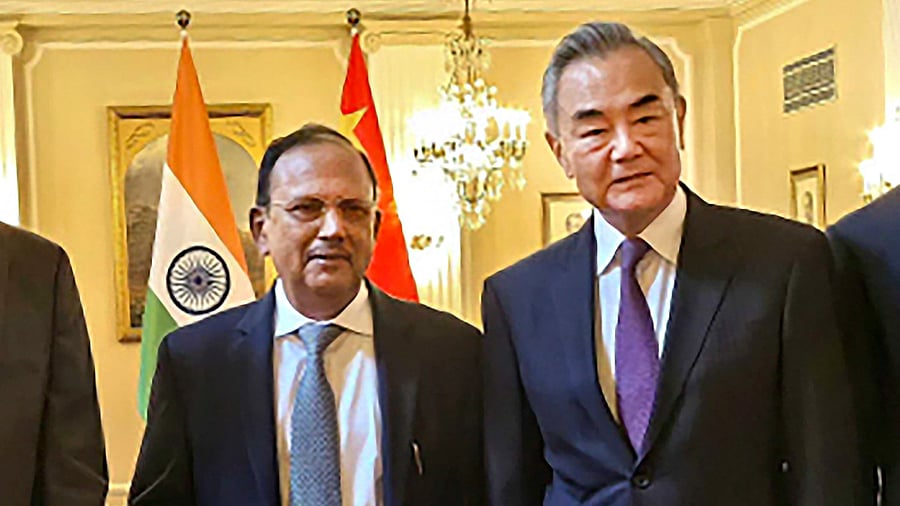
File Photo of Ajit Doval with Chinese Foreign Minister Wang Yi
Credit: PTI Photo
New Delhi: India and China are set to hold the 24th round of boundary negotiations on Tuesday, even as uncertainty persists on ending the moratorium on patrolling in the buffer zones created between February 2021 and September 2022 in some locations along the Line of Actual Control to end the military stand-off in eastern Ladakh.
National Security Advisor Ajit Doval will host Chinese Foreign Minister Wang Yi for the 24th round of boundary negotiations in New Delhi on Tuesday. Doval and Wang, the current special representatives of New Delhi and Beijing for boundary negotiations, had held the last round of talks in Beijing on December 18, 2024.
Wang will have a meeting with External Affairs Minister S Jaishankar shortly after landing in New Delhi on Monday for a two-day visit.
He will call on Prime Minister Narendra Modi after the boundary negotiations on Tuesday, according to the Ministry of External Affairs in New Delhi.
Wang’s visit to New Delhi followed Doval’s and Jaishankar’s recent visits to China. Though the two sides are trying to bring the relations back on track, they have not yet decided if and when the patrolling moratorium in the buffer zones will be lifted.
Jaishankar had said, on December 3, 2024, that the moratorium on patrolling in the buffer zones in Galwan Valley, Pangong Tso northern and southern banks, Gogra and Hotsprings areas could be revisited as and when the situation would demand.
The October 21 deal allowed the Indian Army to resume patrolling in Depsang and Demchok, up to the points, which had been blocked by the Chinese People’s Liberation Army since the beginning of the military stand-off in April-May 2020. Just two days after New Delhi and Beijing had clinched the deal, Modi and Chinese President Xi Jinping met on the sidelines of the BRICS summit at Kazan in Russia, for the first time after the Chinese PLA’s aggressive moves and the counter-deployment by the Indian Army had led to the stand-off in eastern Ladakh.
The new agreement, however, did not end the patrolling moratorium that the Indian Army and the Chinese PLA had mutually agreed upon while creating a three-kilometre-long (about 1.5 kilometres on both sides) “buffer zone” in Galwan Valley on July 6, 2020, just days after the violent face-off between the soldiers of the two sides in the area.
The Indian Army had earlier regularly sent soldiers from its permanent base at the Dhan Singh Thapa Post near Finger 3 on the northern bank of Pangong Tso (lake) for patrolling up to Finger 8. But it had to suspend patrolling after a scuffle between its troops and the Chinese PLA soldiers near Finger 4 in May 2020. The PLA had later built bunkers and observation posts and deployed additional troops in the area, thus denying access to the Indian Army to its earlier patrolling limit at Finger 8. The February 2021 deal, however, had created an eight-kilometre-long buffer zone between Finger 3 and Finger 8 on India’s side of the LAC with China (on Pangong Tso northern bank), with a moratorium on patrolling by both sides.
The new agreement also did not allow the Indian Army troops to go back to the pre-April-May-2020 patrolling pattern neither on the northern and southern banks of Pangong Tso nor on Gogra and Hotsprings areas, where both sides had mutually pulled out troops in August 2021 and September 2022 respectively, after creating similar ‘buffer zones’ and agreeing on the moratorium on patrolling.
